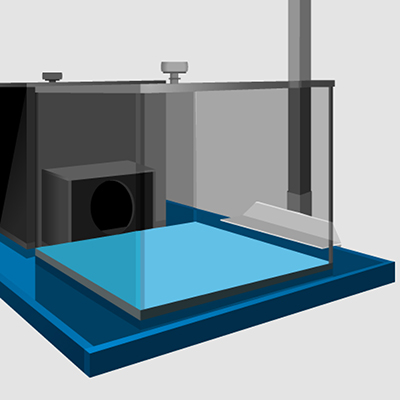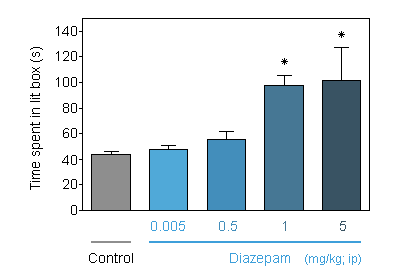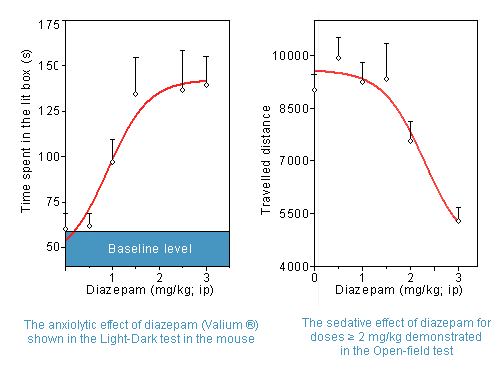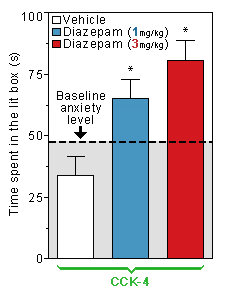Light Dark test in mice
-

-
Presentation
- The light dark (LD) test is used to evaluate the relative anxiety status of mice.
The light dark paradigm in mice is based on a conflict between the innate aversion to brightly illuminated areas and the spontaneous exploratory activity. If given a choice between a large brightly compartment versus a small dark compartment, mice spontaneously prefer the dark. Anxiolytic compounds have been found to increase the total duration of time spent there. Anxiogenic compounds are observed to work in the opposite way.
- The light dark (LD) test is used to evaluate the relative anxiety status of mice.
-
Compound testing
Compound testing addresses the effect of acute treatment on the total duration of time spent in the lit box. Investigation of the effect of subchronic treatment is also possible.
-
Endpoints

Time spent in the lit box (s)
-
Dose-response curve of diazepam-treated mice
in the Light-Dark test. -
Diazepam produces a dose-dependent reduction of time spent in the lit box, suggesting an anxiolytic effect.
Diazepam ≥ 2 mg/kg is associated with reduced locomotion in the OF
which suggests a sedative effect at doses higher than 2 mg/kg. -
-
-
- Light-Dark test in mice is a well accepted model for screening anxiolytic compounds. However, not many CROs offer to conduct this test due to the fact that its sensitivity is highly dependent on the baseline level of the control animals, which is in turn dependent upon careful management of the environmental testing conditions.
Neurofit has offered the Light-Dark test in mice for more than 15 years and produced consistent data throughout this time. It has been implemented not only for drug screening but also for phenotyping purposes.
Moreover, Neurofit also offers a variant of the Light-Dark test in order to mimic the CCK-4 - induced panic anxiety as modelled in human healthy volunteers.
- Light-Dark test in mice is a well accepted model for screening anxiolytic compounds. However, not many CROs offer to conduct this test due to the fact that its sensitivity is highly dependent on the baseline level of the control animals, which is in turn dependent upon careful management of the environmental testing conditions.
Neurofit has offered the Light-Dark test in mice for more than 15 years and produced consistent data throughout this time. It has been implemented not only for drug screening but also for phenotyping purposes.
You could also be interested in
-
Elevated Plus Maze
The EPM test is used to evaluate the relative anxiety status of mice or rats.
Marble burying
Mice bury glass marbles that are present in the cage. This test has some predictive value for anti-depressant and/or anxiolytic drugs.
-
Spontaneous paradigm
Spontaneous paradigm is based on the natural reaction of rodents to stress stimuli.
Depression
Reactivation of a juvenile-like plasticity in the brain for the treatment of depression.

 SPONTANEOUS PARADIGM
SPONTANEOUS PARADIGM

